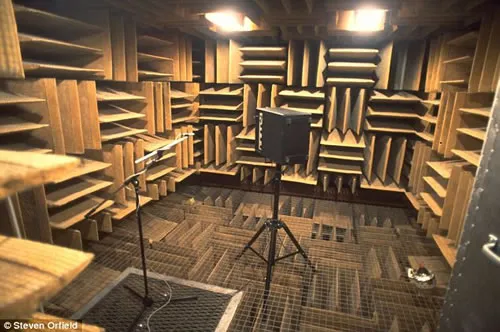World’s Quietest Place
Silence is often associated with peace and tranquility, but what happens when silence becomes too intense to bear? The world’s quietest place—a specially designed anechoic chamber—pushes silence to such extremes that spending time inside it could reportedly drive people crazy. Located at Orfield Laboratories in Minneapolis, Minnesota, this extraordinary room holds a Guinness World Record for its unprecedented quietness.
What Is an Anechoic Chamber?
An anechoic chamber is a unique space designed specifically to absorb sound and electromagnetic waves completely. “Anechoic” literally means “without echo.” The walls, ceiling, and floor are lined with sound-absorbing foam wedges and insulated layers that ensure almost total silence by preventing sound reflections. These chambers are typically used for testing audio equipment, measuring sound levels, and conducting precise acoustic research.
Why Is This Chamber the Quietest Place on Earth?
The anechoic chamber at Orfield Laboratories holds the record as the quietest place on Earth, with background noise measured at an astonishing negative decibel level—around -9.4 dB. To put this in perspective, a quiet bedroom at night typically measures around 30 dB. This chamber is so silent that visitors report hearing their own heartbeat, breathing, and even the subtle noises of their bodily functions, creating a profoundly unsettling experience.
How the Chamber Affects the Human Mind
While complete silence might sound relaxing, spending prolonged periods in the world’s quietest place has been known to drive people to the brink of insanity. The sensory deprivation within the chamber is so intense that many visitors cannot handle it for more than a few minutes.
When the brain receives no external auditory stimuli, it begins to amplify internal sounds, such as breathing, heartbeat, and even blood circulation. The experience quickly becomes disorienting, leading to feelings of anxiety, paranoia, and in some cases, hallucinations.
The Longest Time Spent Inside the Chamber
The longest anyone has reportedly managed to remain in this anechoic chamber is approximately 45 minutes. Most people exit within just a few minutes, overwhelmed by the intense silence and the unsettling sensation of hearing only internal sounds. This powerful reaction underscores how humans rely on ambient noise for orientation and comfort.
Purpose and Practical Uses
While the chamber might seem terrifyingly silent, it serves an essential purpose. Researchers and engineers use anechoic chambers to test sensitive audio equipment, microphones, headphones, and speaker systems, ensuring they can perform effectively even under the most precise conditions.
Moreover, automotive manufacturers test vehicle noise and sound insulation in these chambers to enhance passenger comfort. Aerospace companies utilize them to evaluate how equipment and materials respond to silence and absence of ambient noise. This ensures optimal performance in various environments, including outer space.
Visiting the World’s Quietest Place
Orfield Laboratories occasionally allows visitors to experience the anechoic chamber firsthand, although the experience can be challenging and unsettling. People entering the chamber typically find the silence overwhelming almost immediately, often becoming acutely aware of their own bodily functions and movements.
Anechoic Chamber vs. Normal Quiet Rooms
Anechoic chambers are distinctly different from regular quiet rooms. While quiet rooms might block external noise and be insulated against sound, they still allow for some minimal reflections and ambient sound. In contrast, anechoic chambers completely absorb sound, eliminating all echoes and reflections, creating an environment of absolute silence that is unnatural for humans.
Other Famous Anechoic Chambers
Besides the anechoic chamber at Orfield Labs, another well-known facility is the one owned by Microsoft, located in Redmond, Washington. Microsoft’s chamber previously held the record for the quietest room, measuring at around -20 dB. Like the Orfield Labs chamber, it is also utilized extensively for technology testing and research.
Psychological Effects of Extreme Silence
Experiencing absolute silence can profoundly affect mental and emotional states. Humans naturally rely on ambient sounds for comfort, orientation, and a sense of security. When these sounds vanish completely, it creates a sense of isolation and can trigger anxiety, panic attacks, and disorientation.
The psychological implications of silence, particularly in anechoic chambers, reveal much about human reliance on auditory senses. They highlight how external stimuli shape mental health and well-being.
Why Silence Matters
Despite the unsettling aspects of absolute silence, understanding silence and sound has significant practical implications. Studying silence allows researchers to develop technologies and devices sensitive enough to detect minute sounds, aiding in medical diagnostics, acoustic engineering, and environmental monitoring.
Conclusion
The world’s quietest place at Orfield Laboratories is more than just a curious oddity—it is a testament to human ingenuity and the fascinating relationship we have with sound and silence. While spending extended time in the chamber might feel overwhelming or even terrifying, the research and advancements stemming from this unique space continue to benefit technology, science, and daily life.
Next time you find yourself craving silence, remember: there is such a thing as too quiet!



